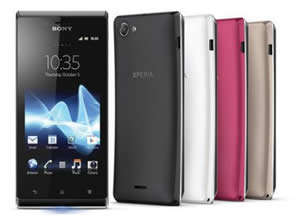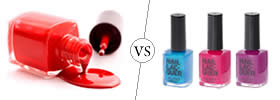Difference between Samsung Galaxy S Duos and Sony Xperia J
Key difference: Samsung Galaxy S Duos is a dual-SIM phone that was launched in September 2012. The phone comes with a 4-inch TFT capacitive touchscreen, with approximately 233 ppi density. The device comes with Samsung’s TouchWiz UI on Android 4.0.4 ICS. Xperia J was announced in October 2012 as a cheaper variant of the Xperia T, resulting in the phone sporting a similar design to the T. The Xperia J features a 4-inch scratch-resistant TFT touchscreen that offers a pixel density of 245.
 Initially smartphones would come in two categories, the no-nonsense simple phone and the extravagant phone with loads of features and a high price tag. However, now there are many people who expect different things from their phone, including features but a lesser price tag, durability, more battery power, etc. This has enabled smartphone manufacturers to offer an array of different phones for the different types of customers. Samsung announced the Galaxy S Duos as an option aimed for people that require double SIM capability, eliminating the need for carrying two separate phones. The phone was launched in September 2012.
Initially smartphones would come in two categories, the no-nonsense simple phone and the extravagant phone with loads of features and a high price tag. However, now there are many people who expect different things from their phone, including features but a lesser price tag, durability, more battery power, etc. This has enabled smartphone manufacturers to offer an array of different phones for the different types of customers. Samsung announced the Galaxy S Duos as an option aimed for people that require double SIM capability, eliminating the need for carrying two separate phones. The phone was launched in September 2012.
At first glance, the Samsung Galaxy S Duos bears heavy resemblance to the company’s flagship phone, the Samsung Galaxy S3. However, looking past the basic form of the phone and picking it up; the user can realize the reason for such a small price tag. The phone is a cheaper version of its big brother, with a lesser quality plastic and some downgraded features. However, let’s not label it as of yet, as it does come with some good specs. The 4-inch TFT capacitive touchscreen, with approximately 233 ppi density, is pretty decent with good contrast and colors but it is too reflective under sunlight, making it a bit difficult to use outdoors without squinting or trying to cover the screen.
The phone itself is easy to hold and handle, making it sleek and small enough to slip into jeans pockets or a small purse when on the go. The 120 grams of weight also ensures that the phone does put that much pressure on the hands when holding the device for longer periods of time. The top of the device houses only the 3.55 mm jack, while the bottom only has the USB/charging port. The right side of the device holds the power button on the top right hand and the microSD card slot. The left side of the device only holds the volume rocker, a bit hard to reach, if a person is used to having it on the right. On the front, the device has the home button that is surrounded by capacitive more options and a back button.
The device comes with Samsung’s TouchWiz UI on Android 4.0.4 ICS. Again, the UI is a toned down version of the one found on the S3. The device lacks the ripples effect and the water-drop sound and has four customizable shortcut buttons on the bottom of the lockscreen that can directly take you to apps such as missed phone calls when unlocking the device. The device allows users to add/remove apps from the homescreen as well as add/remove panels similar to other versions of Android.
The device is powered by a 1 GHz Cortex-A5, with about 786 MB of RAM. The RAM is a slight upgrade to the 512 MB available on other phones, but it still isn’t that great when trying to run dual-SIM, resulting in some lagging during operation. The dual-SIM capability and standby allows both SIMs to be operational at the same time. The device comes with a 5 MP rear camera for taking photos and recording videos. The rear camera is pretty decent in terms of taking photos. The images have pleasing colors and a good dynamic range, but the photos are a bit grainy. The phone also comes with features such as smile detection, geo-tagging, Share shot, effects and panorama mode. The S Duos also houses a VGA (0.3 MP) front camera that is as okay, nothing much to talk about. The phone can also capture videos in VGA resolution at 30fps.
The S Duos comes with a decent removable LI-Ion 1500 mAh battery, that according to the company provides a talk time of 770 minutes in 2G and 520 minutes in 3G, along with a standby time of 570 hours in 2G and 470 hours in 3G. The phone does not come with the same amount of features as available in Galaxy S3, but with the price tag of this device, it is still something. The main reason for purchasing the phone would still be the dual-SIM capability, while in other countries where dual-SIM options are more common, the phone may not fare as well.
 Xperia is a well known brand of smartphones that are a part of the Sony Mobile. The Xperia brand was initially a collaboration with Ericsson but has since then been dissolved. Now, Sony has single handedly taken it upon itself to ship out new phones, while maintaining the level of quality and design of the older versions. In order to garner response for its new line of smartphones, the company started marketing the Sony Xperia T as the Bond phone, which is featured in the movie Skyfall. Xperia J is the shy, younger brother of the Bond phone, and is also cheap to boot.
Xperia is a well known brand of smartphones that are a part of the Sony Mobile. The Xperia brand was initially a collaboration with Ericsson but has since then been dissolved. Now, Sony has single handedly taken it upon itself to ship out new phones, while maintaining the level of quality and design of the older versions. In order to garner response for its new line of smartphones, the company started marketing the Sony Xperia T as the Bond phone, which is featured in the movie Skyfall. Xperia J is the shy, younger brother of the Bond phone, and is also cheap to boot.
The Xperia J was announced in October 2012 as a cheaper variant of the Xperia T, resulting in the phone sporting a similar design to the T. The Xperia J features a 4-inch scratch-resistant TFT touchscreen that offers a pixel density of 245. The pixel density is the not the best among the contenders, but that does not hinder the high-res display that is visible on the phone. The display shows quite smart and sharp images, with very accurate color representation. The display also has excellent viewing angles and does is less reflective under sunlight.
The design of the phone is also quite similar to Xperia T. The phone comes with a plastic chassis that has a sturdy built. The Xperia J has an arched back similar to Xperia Arc series, which is pleasing to hold and grip. The silver plastic lining that graces the other Xperia series has been shifted to the bottom and acts as a second LED indicator during calls. The phone is also quite light, weighing only 124 grams. The Timescape UI is very similar to the original Google Android UI and basically seems like cheap imitations. The phone has three capacitive buttons on the bottom of the screen, Back, Home and Menu buttons. The buttons are placed on the far bottom of the device, making it more prone for the user to drop the device. The top of the device houses the 3.5mm jack, while the left side has the USB/charging port. The right side of the device is quite busy with the power/lock key on the top right hand and the volume rocker just below the power key.
The device is powered by 1 GHz Qualcomm processor and only 512 MB, which makes the device a little glitch and lagging when trying to shift screens as well as switch apps. The device, when not multitasking and doing basic functions, still lags a little. The device comes with 4 GB of internal space, of which only 2 GB is available to the user. This is very little compared to phones that are offering 8/16/32 and even 64 GB. However, the company has provided a SD card slot that allows users to expand memory by another 32 GB.
The device houses a 5 MP rear camera with autofocus feature. Just above it, a LED flash light can also be found. However, the front camera and the video recording capabilities are a little disappointing. Both, the front camera and video recording are VGA, which does provide the best resolution. The 5 MP camera is pretty decent, but if you have gotten used to the high-res 8 and 12 MP cameras, this camera will not at all be pleasing. The camera takes decent photos, but it isn’t sharp, clear or even HD for that matter. However, the phone does come with juice, 1750 mAh to be exact. This ensures that the phone last a couple of days when not in constant use and at least a full day when working with it all day. The company does offer features such as Wi-Fi hotspot, Bluetooth and USB, but it does not offer NFC capabilities.
The information for the detailed table about the two devices has been taken from Samsung website, Sony Mobile website and GSMArena.com
|
|
Samsung Galaxy S Duos |
Sony Xperia J |
|
Launch Date |
September 2012 |
October 2012 |
|
Company |
Samsung |
Sony |
|
Size |
121.5 x 63.1 x 10.5 mm |
124.3 x 61.2 x 9.2 mm |
|
Display |
4.0-inch TFT capacitive touchscreen |
4-inch scratch-resistant TFT touchscreen |
|
Screen |
480 x 800 pixels (~233 ppi pixel density) 16M colors |
480 x 854 pixels (~245 ppi pixel density), 16 million colors |
|
Protection |
No |
Corning Gorilla Glass |
|
Weight |
120 grams |
124 grams |
|
2G Network |
GSM 850 / 900 / 1800 / 1900 - SIM 1 & SIM 2 |
GSM 850 / 900 / 1800 / 1900 |
|
3G Network |
HSDPA 900 / 2100 - SIM 1 & SIM 2 |
HSDPA 900 / 2100 - ST26i HSDPA 850 / 1900 / 2100 - ST26a |
|
4G Network |
N/A |
N/A |
|
GUI |
TouchWiz 4.0 UI |
Timescape UI |
|
CPU speed |
1 GHz Cortex-A5 |
1 GHz Qualcomm processor |
|
GPU |
Adreno 200 |
Adreno 200 |
|
OS |
Android OS v4.0 (Ice Cream Sandwich) |
Google Android 4.0 (Ice Cream Sandwich) |
|
Chipset |
Qualcomm MSM7227A Snapdragon |
Qualcomm MSM7227A Snapdragon |
|
RAM |
768 MB |
512 MB |
|
SIM Size |
miniSIM (Dual-SIM handset) |
miniSIM |
|
Internal Memory |
4 GB (1.8 GB available to the user) |
4 GB (2 GB available to user) |
|
Expandable Memory |
Up to 32 GB |
Up to 32 GB |
|
Sensors |
Accelerometer, Geo-magnetic, Proximity Sensor |
Accelerometer, Proximity sensor, Magnetometer |
|
Connectivity |
GSM; EDGE/GPRS (850/900/1,800/1,900MHz); HSDPA 7.2; Wi-Fi 802.11b/g/n 2.4GHz; Wi-Fi Direct; Bluetooth |
GSM GPRS Up to 86 kbps (download). Up to 86 kbps (upload); GSM EDGE Up to 237 kbps (download). Up to 237 kbps (upload); microUSB v2.0; DLNA; Wi-Fi hotspot; Wi-Fi; Bluetooth |
|
Data |
GPRS, EDGE, WLAN, Bluetooth, USB. |
GPRS, EDGE, WLAN, Wi-Fi hotspot, Bluetooth and USB. |
|
Speed |
HSDPA, 7.2 Mbps; HSUPA, 5.76 Mbps |
HSDPA, 7.2 Mbps; HSUPA, 5.76 Mbps |
|
WLAN |
Wi-Fi 802.11 b/g/n, Wi-Fi hotspot |
Wi-Fi 802.11 b/g/n, DLNA, Wi-Fi hotspot |
|
Bluetooth |
Bluetooth v3.0 with A2DP |
Bluetooth v2.1 with A2DP, EDR |
|
USB |
microUSB v2.0 |
microUSB v2.0 |
|
Primary Camera |
5 MP CMOS rear camera |
5 MP 2592х1944 pixels rear camera |
|
Secondary Camera |
VGA CMOS front camera |
VGA (0.3 MP) front camera |
|
Video |
VGA@30fps |
VGA |
|
Camera Features |
|
|
|
Sound Enhancement |
No |
xLOUD Experience Clear Stereo |
|
Audio supported formats |
AAC, AAC+, AMR, AMR-NB, AMR-WB, eAAC+, I-Melody, IMY, M4A, MIDI, MP3, OGG, SP-Midi, WAV, WMA |
MP3/ eAAC+/ WMA/ WAV player |
|
Video supported formats |
MPEG4, H.263, H.264 |
MP4/ H.263/ H.264/ WMV player |
|
Battery Capacity |
Removable Li-Ion 1500 mAh battery |
Removable Li-Ion 1750 mAh battery |
|
Talk time |
2G: 770 minutes 3G: 520 minutes |
2G: 5 hours 36 min 3G: 607 hours |
|
Stand-by |
2G: 570 hours 3G: 470 hours |
2G: 7 hours 18 min 3G: 618 hours |
|
Available Colors |
White, Black, La Fleur |
Black, White, Pink, Gold |
|
Messaging |
SMS (threaded view), MMS, Email, Push Email |
SMS (threaded view), MMS, Email, IM, Push Email |
|
Browser |
HTML, Adobe Flash Lite |
HTML5, Adobe Flash |
|
Radio |
Stereo FM radio with RDS |
Stereo FM radio with RDS |
|
GPS |
GPS with A-GPS support |
GPS with A-GPS support |
|
Java |
Java via Java MIDP emulator |
Java via Java MIDP emulator |
|
Additional Features |
|
|
Image Courtesy: samsung.com, sonymobile.com









Add new comment